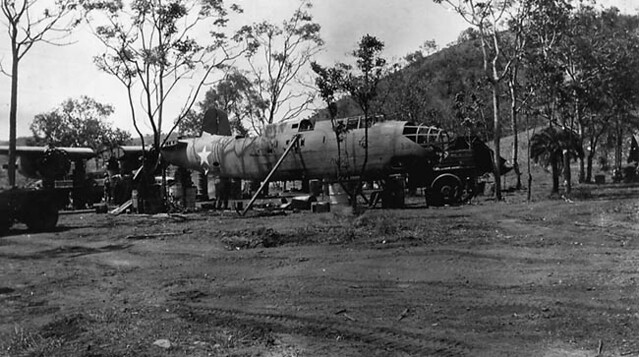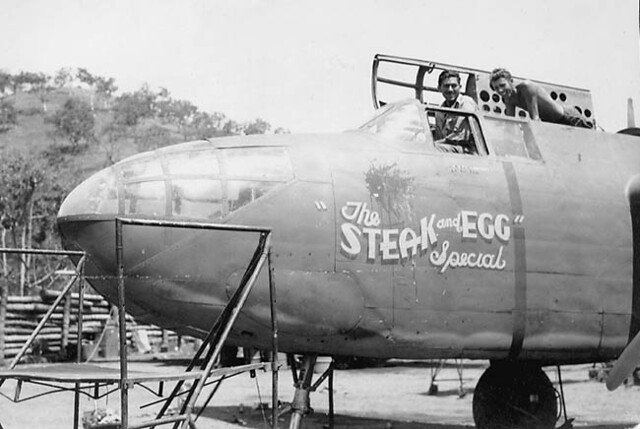For the men stationed in New Guinea during 1942 and 1943, a variety of fresh food was not easy to come by. There were plenty of coconuts, although the men grew tired of eating them, and the occasional banana, but no other fresh fruits or vegetables. Whatever came through was canned. By the end of 1942, they decided that they had had enough of the canned fruits and vegetables and began working on their own plane that would ferry fresh food from Australia.
This plane, an A-20, was being built from scrapped pieces by T/Sgt. Kip Hawkins and a few other mechanics from the 89th Bomb Squadron. The fuselage was taken from LITTLE HELLION, which belly-landed on November 1, 1942, and the wing sections from THE COMET, which was scrapped after the nose wheel collapsed while the plane was being towed on December 15, 1942.

An A-20 named THE COMET was scrapped after its nose gear collapsed. The wings from the aircraft were taken and propped up on barrels, ready for a new fuselage of the aircraft that would become THE “STEAK & EGG” SPECIAL.

Here, the scrapped fuselage from the A-20 formerly known as LITTLE HELLION is being slid between the waiting wings propped up on barrels.
It was a slow reconstruction that lasted all of January 1943, as the mechanics had to go through a lot of scrap piles around Port Moresby for various parts. At one point, a wing that was propped up on barrels fell right on the head of a mechanic. Luckily, he escaped without serious injury. Soon enough, the fuselage was slid between the wings and the aircraft was put together. The A-20, now named THE “STEAK & EGG” SPECIAL, was christened with eggs on February 4th.

T/Sgt. Clifton H. Hawkins and Cpl. Schraam sit in the A-20 after its dedication on February 4, 1943. Notice the splattered egg above the name.
Given the nature of how this A-20 came to exist, there were a few mechanical problems to work out. Once fixed though, the aircraft regularly made trips from Port Moresby to Australia. The Squadron enjoyed the fresh food and meat immensely. In August, the paint was stripped and the aircraft was renamed STEAK & EGGS, then later STEAK AND EGGS (without the ampersand). On June 11, 1944, STEAK AND EGGS was low on fuel when it flew into bad weather. Both factors led to a forced landing on an Australian beach and the subsequent end of the aircraft. No one was seriously injured in the landing. Parts of the aircraft were salvaged, with the rest still on the beach today.
Read more about the missions of this aircraft, including a stories from a veteran who flew the plane, at Australia @ War.

Another great post – thanks!!
LikeLiked by 2 people
Thanks, glad you liked it!
LikeLike
A really excellent story! Somebody should go and get the few bits that remain to put them in a museum. It would be a pity if they just melted away after such a heroic career.
LikeLike
It would be nice to see what’s left of the plane on display. No doubt the story would grab the interest of visitors.
LikeLike
A fabulous story! How the mechanics managed to put together pieces from scrapped aircraft to create a flyable one, is just amazing!
LikeLike
They had a great idea! Not to mention it was a good way to improve their mechanical skills.
LikeLiked by 1 person
Absolutely. Quite cheeky too, I’m surprised they managed it!
LikeLiked by 1 person
Have you run across anything similar happening in Europe?
LikeLiked by 1 person
I can’t say I have, certainly not in war time! Lots of cannibalising of aircraft but none rebuilt in this manner.
LikeLike
Love the story how they put the plane together! Great post.
LikeLike
Thank you!
LikeLiked by 1 person
Reblogged this on Pacific Paratrooper and commented:
Another well researched and interesting post from the IHRA.
LikeLiked by 1 person
Thanks for the reblog! 🙂
LikeLike
Certainly my pleasure !!
LikeLiked by 1 person
Great story!
LikeLike
Glad you enjoyed it.
LikeLiked by 1 person
Great story about American ingenuity. But I wonder how hard it was to find a volunteer, to be the first pilot to fly this thing.
LikeLike
Major Christian Petri took the A-20 for its first flight. Not sure if we have any record of his feelings about it.
LikeLiked by 1 person
Fantastic. Those two fellows, Kip and Joe, sound a bit like something out of MASH. Wonderful post.
LikeLike
Funny, it does seem like it could be a twist on a M*A*S*H episode. The Adam’s Ribs one, by chance? Glad you enjoyed the post.
LikeLike
Other way around. I think Kip came up with the reality long before the MASH people did.
LikeLiked by 1 person
Delightful story. They did better than soldiers of Union in Civil War. Unless they looted farms they had hardtack and potted meat in cans which the corrupt manufacturers “stretched” with sawdust.
LikeLike
They ate a lot of Spam, though we haven’t seen anything mentioning sawdust in there. Glad you enjoyed the story.
LikeLike
Excellent insight into the ingenuity back in those days, those foodstuffs were valuable.
I recall the Americans had Milk and Ice Cream flights into Vietnam daily, ironic how the needs change as war becomes more technological. Cheers.
LikeLike
Fresh milk and ice cream were very rare treats for these guys during WWII. They probably didn’t have the space or resources to store either one.
LikeLiked by 1 person
Really interesting post..I love personal stories like this from the War…that is REAL history!!
LikeLiked by 1 person
We have quite a few scattered throughout the pages of our blog. Thanks for reading!
LikeLike
Genius!!! I have to tell you, GP, that Jamie had to do a term paper on WW2 and it was supposed to be min. 5 paragraphs long with 5 works cited. Jamie’s was 8 pages/19 works cited. You should have seen the teacher’s face when he turned it in! LOL!!!
LikeLiked by 1 person
A wonderful story. My dad was a WWII airplane mechanic and he would have absolutely done something like this.
LikeLiked by 1 person
Glad you enjoyed reading it! Where was your dad stationed?
LikeLike
It just goes to show how if you want something bad enough, there’s always a way. What crafty young men!
LikeLiked by 1 person
Talk about ingenious creativity solving a problem that would seem at first glance insurmountable. Your writing is always worth reading.
LikeLike
Thank you very much! And it sounds like they had to get pretty creative once in awhile to find solutions to various problems. It wasn’t always easy to get things in a timely fashion. Other units would just use an old plane for a “fat cat” (or one would mysteriously disappear from the roster), but this way is much more interesting.
LikeLike
Would take a pretty brave pilot for the first test flight. Great story.
LikeLike
Thanks for reading!
LikeLiked by 1 person
A pleasure.
LikeLike
Reblogged this on quirkywritingcorner and commented:
I loved this story! ~ Connie
LikeLiked by 1 person
Thank you for reblogging our post!
LikeLike
Very Interesting.
LikeLike
We thought so too. 🙂
LikeLike
Wow lovely write up. your blog is a great readinf place for me. thx
LikeLike
Thank you for stopping by and for the reblog!
LikeLiked by 1 person
Reblogged this on Kamal Kothari.
LikeLiked by 1 person
So great you’ve written these stories to share and if you have grandchildren – they will know. My father in law worked in B-29, my husband was crew chief on b52’s. My dad was in the Navy and was at Bikini Atoll for all three atomic bomb testing. How I wish he had written his stories. Keep writing!
Jeanne
LikeLike
We want everyone who’s interested in this subject to be able to read these stories. Even better if the people who find them are relatives to someone in a particular post (which happens once in awhile). Hope you can find out as much as possible about your father’s service.
LikeLiked by 1 person
Pingback: International Historical Research Associates | Putting Together The Steak and Egg Special
Extreemly well written article and it provides some real insight into our history.
Please do read/follow my blog on aircrafts and aviation as well.
blogthejetboy.wordpress.com
LikeLike
Thank you, glad you enjoyed it.
LikeLike
Pingback: Looking Back at Our Top Posts of 2016 | IHRA
Pingback: Repost: Building the Steak and Eggs Special | IHRA